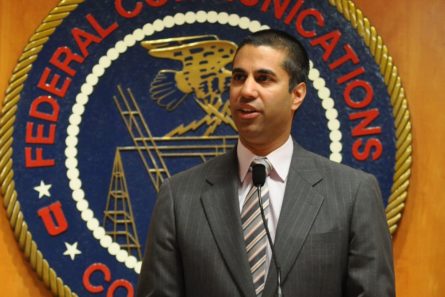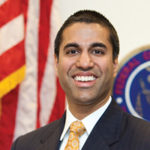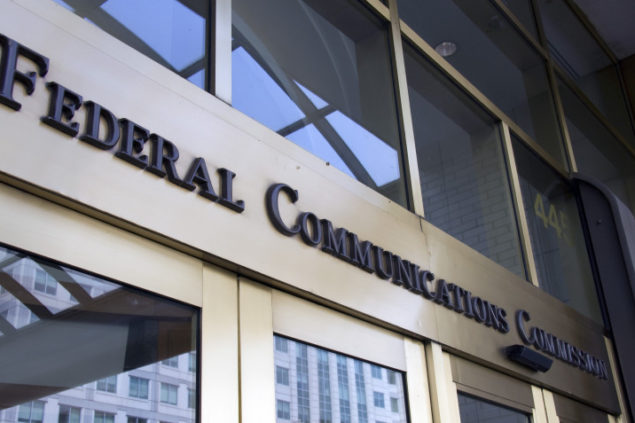Tech Roundup Episode 9 – COVID-19 and the Internet: A Conversation with Ajit Pai

In this episode, Ajit Pai joins Adam Thierer and Brent Skorup to discuss the principles driving the Federal Communications Commission in recent years, the “Keep Americans Connected” pledge, and how things have changed for the FCC in the midst of the COVID-19 pandemic.
Transcript
Although this transcript is largely accurate, in some cases it could be incomplete or inaccurate due to inaudible passages or transcription errors.
Adam Thierer: Hello and welcome to the latest installment of the Tech Roundup Podcast, which is part of the Regulatory Transparency Project’s ongoing Fourth Branch Podcast series. The Tech Roundup Podcast features leading policy experts debating the major legal issues surrounding various emerging technology industries and issues. My name is Adam Thierer of the Mercatus Center at George Mason University, and I will be your host for today’s episode.
Today, we have a very special edition of the podcast because we’re honored to be joined by Ajit Pai, who’s the Chairman of the Federal Communications Commission. He was designated chairman by President Trump in January of 2017 after previously serving as Commissioner at the FCC since 2012. He previously held several other council positions at the FCC, the United States Senate Judiciary Committee, and the U.S. Department of Justice.
I should also add that Chairman Pai runs the most active and actively entertaining Twitter feed of any regulator on the planet, and I highly recommend you all follow him there, if you aren’t already doing so. Chairman Pai, welcome to the show and thanks for joining us today.
Hon. Ajit V. Pai: Thanks so much for having me on and for the gratuitous Twitter plug. I’m glad to see that someone’s entertained by my random musings on everything but the FCC.
Adam Thierer: We love it. And it’s also my pleasure to welcome my colleague Brent Skorup back to the program. Brent is a senior research fellow at the Mercatus Center. And his research areas include transportation technology, telecommunications, aviation, and wireless policy issues. Brent, welcome back to the show.
Brent Skorup: Great to be here. Thanks for having me.
Adam Thierer: Well, let me start with you, Chairman Pai. And before we start discussing how things have changed for the Federal Communications Commission in the wake of the COVID outbreak, which a lot of our audience will want to hear from you about, let me first ask you to take a step back and offer us some perspective on how the priorities of the FCC have changed during your chairmanship and what principles have informed your regulatory philosophy as chairman of the FCC.
Hon. Ajit V. Pai: That’s a good question. It’s certainly a challenge in some respects to answer it since we’re still in the middle of the sprint. But trying to step back, I guess I would say that some of the principles that have animated the last three years of the FCC’s work have been, number one, a determination to modernize our regulations to match the modern marketplace. So much of the edifice of FCC regulation over the years has been built and accreted over time without any consideration of first principle. Do those rules still matter? And that’s one of the things that, from media to wireless, cable to satellite, we’ve taken a comprehensive look at.
Secondly, the deep respect for economics and engineering — I think, nothing against lawyers, I am one myself. But I think over the years the FCC’s work had tended to focus more on the legal and policy aspects of things as opposed to the engineering and economic aspects. So we try to incorporate a little bit more, including, for example, setting up an Office of Economics and Analytics and creating and Honors Engineer program.
The third thing would be, notwithstanding what I just said about lawyers, a greater respect for the rule of law, cueing to the boundaries of our jurisdiction as set forth by Congress. It’s very important for us to do that, of course, for legal reasons but I think also because it inspires greater confidence that the Agency is acting consistent with the will of the elected branches of government. And then, finally, I guess I would say just speed and transparency, some of the basic good government principles I’ve really thought about for a long time.
And now that I’ve had the chance to be chairman, we’ve adopted some of those reforms. For example, the radical notion we should actually publish our proposals and orders before we vote on them at our monthly meetings. For years that had never been the case. I never understood why that was so. My second week in office we made it so. And it’s been tremendously helpful in allowing us to tell the American public what we’re planning to do before we actually do it.
At a high level, those are some of the things that we’ve tried to do. You were talking earlier about the Twitter account. I will say that trying to be more responsive and accessible in that kind of forum has been important to me, getting the message out and also hearing input from people. So I didn’t mean to say it’s a core principle of what we try to do, but it has been important, at least to me, in getting feedback and sharing it.
Adam Thierer: Yeah. It’s been remarkable and refreshing to see a sitting regulator be so responsive to the public on a new platform like Twitter. This is, as I often tell others, just something that just would never have happened even just 10, 15 years ago. So it’s a major change in that regard.
Another major change, of course, is the fact that we live in a very different world than we did just a few months ago because of the coronavirus crisis. Let me ask you to say a few words specifically about how things have changed at the FCC in response to the crisis and specifically about the “Keep Americans Connected” pledge. How did that come about and how, more generally, is the FCC responding or adapting to the COVID-19 crisis?
Hon. Ajit V. Pai: Both very good questions. So internally, at least, it has changed how we operate quite a bit. We were one of the first agencies, if not the first, to shift to telework by default, with a few minor exceptions. And that’s been a big change for us. And making sure our IT teams were able to connect everybody virtually has been really important. Our staff’s health and safety has been my number one priority, so we’ve relaxed some administrative rules, for example, granting more flexible leave policies and the like so people can take care of kids or elderly relatives and the like. And those are the kinds of things that are important to me just so that our staff knows that we ask a lot of them and we’re also going to be there for them during a situation like this.
In terms of the external facing efforts, we’ve been exceptionally busy. The centerpiece of our work, as you mentioned, has been the “Keep Americans Connected” pledge, making sure that no consumers, whether individual users or small businesses, lose access to their internet or telephone services due to some of the disruptions that have been caused by the pandemic, to ensure that broadband and telephone providers make Wi-Fi hotspots available to anyone across the country who might need them. I’ve also challenged some of these providers to go even above and beyond the pledge. And you can see some of these efforts at FCC.gov/keepamericansconnected.
But they’ve done things like relaxing or eliminating data caps, increasing speeds at no charge to the consumers, offering new low-income offerings and the like. And I’m really grateful to everybody, both our agency staff, as well as the broadband providers across the country for stepping up. Over 700 of them have now signed this pledge, and it’s been really helpful for American consumers who are worried about so much in this time to take one less thing off their plate, to know that connectivity’s going to be there for them when they need it. And that’s been especially critical.
The other piece not related to the pledge I should mention is that we’ve also pulled out the stops across the board in terms of regulatory relief to enable companies to deliver services, granting emergency access to spectrum, for example, that has allowed everyone from T-Mobile in New York City to a small wireless provider in Navajo Nation to get access to spectrum to address increasing consumer demand. We’ve relaxed deadlines for companies so that they can focus on providing services as opposed to paperwork and our E-rate and Rural Healthcare Programs. On the consumer side, we’ve relaxed some of the requirements in the Lifeline Program to ensure the consumers can continue to have service.
So it’s been an exceptionally busy time. All of this comes on top of our normal workload. So I’m really grateful to the hardworking FCC staff for helping us do all this.
Adam Thierer: Yeah. That’s great. Let me bring Brent into the conversation now and, Brent, ask you specifically to build on what Chairman Pai just discussed, specifically maybe talk a little bit about how you feel the tech and telecom industries have been doing in response to the crisis. I know just before we started our podcast, you and I were chatting privately about how you’ve been a wireless-only house for a long time now. And you’ve been pleasantly surprised by how well things have worked out. And I have too. This has been a stress test for so many institutions and industries. And how would you think the telecom and health industries have fared relative to others in responding to this crisis?
Brent Skorup: Certainly. Thank you. And I want to thank the Chairman for coming as well. Thank you for making the time to do this. The industry as a whole — yeah. In the news, in news reports, it seems like the industry is responding pretty favorably, especially when compared with other countries.
Anecdotally, as you said, I’m one of a growing number of people who are mobile-only, hotspot-only. And if the network was going to fail, I’m sure it would be during this podcast. But I’ve had no issues.
Providers, when they estimate how data use has changed, some of these are predictable: a lot more Zoom, a lot more Netflix, a lot more gaming. On the whole, networks have been pretty resilient. The wireline companies, the cable and telecom companies, say typically their data usage is up 20 or 30 percent. The biggest change is probably a longer peak of usage, whereas you’ve probably seen these graphs where data usage peaks in the morning and in the evening. And today, it’s a more consistent peak in the afternoons and evening.
Cellular networks, likewise, have seen increased capacity. CTI says data use is up 2 to 20 percent, not as much as wireline. But cellular is also up. As the Chairman said, companies are not only fulfilling the pledge and agreeing with the pledge, they’re doing different things depending on the carrier. Often for cellular carriers they’re increasing the hotspot usage you can use in a month. T-Mobile made their limited data plans — they made it unlimited for the next two months.
And on the wireline side, cable and phone operators are — they often have, say, low-income pricing for folks. And they’re waiving late fees and so forth. On the tech side, tech companies likewise, I would say, and people seem pretty pleased with tech companies. A lot of us are realizing just how reliant we are not only on the broadband networks but on tech and apps and things like grocery delivery.
And the companies are also — telecom and tech companies have geolocation data, which to help public health authorities, they are aggregating it. So Google, Apple, and Facebook are taking geolocation data and aggregating it, de-identifying it, and providing it to public health officials to give some proxy of compliance with stay-at-home orders or stay-at-home norms. And Google and Apple recently announced that they’re working on a Bluetooth app which would allow public health authorities to do more contact tracing for the coronavirus.
It remains to be seen what that’ll look like, but it’s kind of all hands on deck. This is obviously a national crisis, and the telecom and tech companies are trying to do their part.
Adam Thierer: Yeah. One of the more entertaining things about the coverage of technology, because I’ve monitored this now for so long, for 30 years, in the sort of rollercoaster of media coverage and responses — but just a few months ago, all we were talking about with regards to tech, telecom, digital industries was a so-called, quote/unquote, “tech lash” and all the problems that we supposedly had with technology and technology companies. And yet now I can’t pick up the New York Times or Washington Post without reading a headline about how essential these services are to our lives and how great they’ve been and what a godsend they’ve been in a time of crisis. So it’s certainly ironic to see that turnaround in such short order. But it’s also refreshing and rewarding to think that that’s the case.
Let me ask you both about something different that caught my eye the other day. You’ve probably seen it because you are both so active on Twitter. But the great digital entrepreneur and venture capitalist, Mark Andreessen, just recently published a provocative and important essay entitled “It’s Time to Build.” And his essay highlighted the imperative that companies and regulators and entrepreneurs get serious about building again, in general, just across many different sectors and areas in the various broadest sense.
Are we seeing enough building generally speaking in the U.S. tech and telecom industries? And how does this relate internationally? And specifically if there are market or regulatory factors that are out there that could be holding back the pace of tech and telecom build out competition, what are they? So Chairman Pai, let’s hear from you first on that general question.
Hon. Ajit V. Pai: Very good question about a very interesting topic. I did read Mark Andreessen’s essay, and I found it very provocative. And it echoes much of what I’ve been saying over the last three years in our space, which is that, with respect to telecom networks, it’s very difficult in many cases to build a business case for raising capital and deploying networks.
It’s obviously capital intensive, labor intensive, as well, and, in some cases, regulatory intensive so to speak. And that’s why over the last three years we’ve focused very much on the light-touch regulatory framework because we believe the market-based framework, as opposed to a more government-driven, utility-style framework, is the one best calibrated to promote the maximum incentive for any company, big and small, urban or rural, to build these networks. And I think the results speak for themselves here in the United States.
Over the last three years, we’ve seen infrastructure investment go up. We’re going to be reporting to the FCC that CapEx in 2018 was $80 billion. We set records for fiber deployment in 2018 and 2019. We’ve seen millions more Americans get access to the internet. And we’ve used market-based frameworks for allocating scarce federal funding so that there’s both accountability on the backend but also fiscal responsibility on the frontend as we dispense these funds. So overall, I think, the fact that during this pandemic we’ve been able to withstand something like 20 to 35 percent increase in fixed broadband usage, depending on the part of the country and the time of the day, I think speaks to the fact that this didn’t happen by accident, that we made the right decisions over the last three years to put our companies in a position where they felt confident to spend this money building infrastructure for situations like this.
And I think a useful comparison is Europe. They, of course, have embraced a much more utility-style approach. The member-states tend to be more regulatory. And as a result of that, European infrastructure investment is a fraction of what it is in the United States. And I know that there are some critics of the FCC here in the U.S. which to look to Europe as a model for regulation. But look what’s happening during the pandemic now. And Thierry Breton, the European Commissioner for Internal Markets and Services had to go to companies like YouTube and Netflix and beg them to proactively throttle content so that those networks wouldn’t be overwhelmed. I was just on a call earlier today where Europeans talked about one of the key steps they’ve taken to preserve connectivity has been reducing bandwidth by reducing video content from HD to SD.
To me, that’s not a sign of success. That’s a sign of failure of the regulatory model overall. So I think that, notwithstanding the criticism and, frankly, the hysteria we’ve seen around some of the FCC’s decisions over the last several years, such as net neutrality, I think ultimately the proof has been in the pudding. The American consumer’s much better off than he or she would have been had we embraced the backward looking, risk averse, frankly tired model of utility style regulation.
Adam Thierer: Yeah. I think that’s a really important point. And Brent, let me bring you in on this and ask you a follow up to build on what Chairman Pai just said because there’s been, of course, an absolutely epic battle that’s unfolded over the last decade or so about so-called net neutrality efforts. And there’s been so much litigation and back and forth. And yet, there was so much Chicken Little talk about the sky falling following the repeal of the old rules.
And it’s been remarkable to me that there’s not more people being held to account now for all of that apocalyptic thinking and rhetoric. So maybe you can just discuss that more generally about what’s happening now to the broader net neutrality movement and the ongoing litigation on that front.
Brent Skorup: Yeah. The net neutrality — it’s really a remarkable movement in a lot of ways. I’m sure it will be studied for a long time. I was curious. I looked up on Google Trends net neutrality search terms. And net neutrality in December 2017, when the FCC was moving to repeal the Title II rules, which activists call net neutrality — so when there was peak attention to it in December 2017, more people were searching for net neutrality than were searching for Donald Trump on his Inauguration Day, which it’s remarkable just how much interest there was. I don’t know — Donald Trump on Election Night, but on Inauguration Day, it didn’t compete with net neutrality in December 2017.
Since then, however, interest has plummeted. I was playing with Google search terms just searching for mundane things. And I came up with shoelaces. People are more interested in shoelaces right now than the net neutrality. So there’s this amazing peak and kind of disinterest.
I think a lot of that is because, as you said, there was a lot of concern and a lot of news attention to this idea that the internet would break down, that ISPs and big companies would be doing all sorts of funny things online, things that they’d never done before. And as I, and I expect the Chairman and many others expected, it never happened. This catastrophe never happened. In fact, as the Chairman said, one of his priorities and this FCC’s priorities has been building, what Mark Andreessen talks about, building infrastructure.
And I think one of the first things Chairman Pai did when he was elevated to chairman was create the Broadband Deployment Advisory Committee, which I’m honored to be a member. And getting — how do we get broadband more competition in urban areas and more providers into rural areas where there’s investment challenges? And so it’s remarkable.
In the U.S., we’re often compared to our European peers, and the U.S. compares very favorably to European investment, for instance. There seems to be this tradeoff. You can have low prices as you see in Europe, but you get low investment, generally speaking. In the U.S., for whatever reason, for a lot of reasons, we’ve shown a different path. We want more competitors. We want more investment, and it shows up. Prices are higher — tend to be higher in the U.S. But you see U.S. investment is 50 to 100 percent higher than in Europe on a per capita basis. So that seems to be the tradeoff and that’s one the U.S. has made.
And as far as the net neutrality litigation, in the fall, there was litigation over what Chairman Pai’s FCC did, which was repeal the Title II common carrier regulations for the internet. The D.C. Circuit largely upheld that decision. They felt bound by precedent. The Brand X case that the FCC could classify broadband as a Title I lightly regulated service or a Title II, common carrier service — and D.C. Circuit upheld that.
There was — the court did not fully support the FCC in their preemption of states. They said the FCC would actually have to show conflict with the federal policy of nonregulation. It couldn’t just wholesale preempt states. So that’s a remaining issue, but I don’t think it’s a major one. If a state is going to regulate, is going to enforce net neutrality. I just don’t see how they can do it for any manner of time because they would be saying that telecom — that broadband telecom service is in the state. And the FCC is saying the opposite, that it’s an information service and it’s interstate. But right now, the Title I regime is back and forth.
Adam Thierer: Chairman Pai, let me ask you. I mean, you’re very modest in that you’re the sort of example of regulatory humility that I always think we need to have in our regulators. So I don’t expect you will do it, but I will do it on your behalf. This was a sort of “I told you so” moment for you and for the agency because it seems to me like all the critics on the net neutrality front were really predicting really just an astonishing amount of extreme apocalyptic rhetoric. And a lot of it was personal attacks on you.
It was an astonishing moment to watch as a regulatory analyst for me. And I’d never really quite seen anything like it in all my decades of covering regulatory policy — the kind of personal attacks on you. But maybe just more generally you can talk about how, in a way, I think what you were saying at the time, you’ve been vindicated. This is, as Brent suggested, this is generally a good news scenario. And the stress test that we’ve witnessed with the COVID crisis has really proven that more than anything else.
Hon. Ajit V. Pai: I couldn’t agree more, and I think each of you has put very well the state of the world, almost, what, two and a half years after we made this decision. And it was, in fact, the right decision for consumers, as I said at the time. And every now and then I think back to some of the ridiculous predictions that were made. “You’ll have to pay $5 per tweet,” the entire Senate Democratic Caucus tweeting out in 2018. “The internet will work one word at a time.” Or my favorite that I saw on CNN’s online site, “This is the end of the internet as we know it.”
And remarkably enough, now in April of 2020, people are still able to tweet, to post to Instagram, to watch Netflix, do all the other great things that we do with broadband. And in fact, they’re able to do it quicker and better than ever before. Speeds in the United States are up over 80 percent since we made that decision in December of 2017. As I said before, millions more Americans are getting access to the internet, and the internet remains free and open.
It’s remarkable to me in the context of the current pandemic to see some people occasionally tweeting to me or emailing, “Now, see, don’t you wish it was regulated as utility?” My answer is absolutely not. I mean, look at the comparison to Europe as we discussed earlier. If you want the utility-style regulation, great. But you’re going to get an internet that is subpar compared to what we have now with the market-based framework.
There are always going to be some — and I’m sure each of you know some of these advocates here in the D.C. area. Literally, their answer to every single telecom issue is net neutrality, even some non-telecom issues. It’s like, “Oh, I had one instance of buffering. If we had net neutrality, it wouldn’t be a problem.” There are several Americans who don’t have access to the internet. “Oh, if we had net neutrality, it wouldn’t be a problem.” “I got a mosquito bite the other day.” “If we had net neutrality, that wouldn’t have happened either.”
Literally any ill that exists in American society they fall back on it. And it’s sort of like the Japanese soldiers who, after World War II, stayed hidden in caves for several years. They didn’t know the war was over. In this case, too, the model of light-touch regulation has proven to be correct. The American people have moved on.
And every now and then, it’s kind of gratifying when I travel around—when I was able to travel around anyway, pre-pandemic—and I’d meet some young people who would recognize me. “Hey, wow. That’s pretty cool. You’re the guy — you’re the net neutrality guy, right?” And they’d want to take pictures. But it’s not in any way hostile whatsoever. They acknowledge now we were sold a bill of goods and we were told the internet was going to fail. And it didn’t. And I get some emails suggesting that as well, that we were wrong about it.
So I would hope that now that the passion has somewhat receded, at least compared to shoelaces according to Brent’s able research, we can move on to what really matters, which is setting a regulatory framework that maximizes investment, increases consumer welfare and focuses more on policy instead of the politics and the personal attacks. I appreciate you noting that, that the only concrete result of this is that two people went to jail: one for threatening my family and one for threatening the agency. And I don’t think that discord was anything that the American people who engaged in it have anything to be proud of.
Adam Thierer: Yeah. That’s a good point. Go ahead, Brent.
Brent Skorup: Small point on this investment issue, this is not just an academic issue. You see it in the data. Bloomberg reported recently, for the most recent six years we have data, Europe’s telecom companies — the value of those companies fell 50 percent in the most recent six years. The value of the U.S. sector’s increased 70 percent. So it’s a very different investment effects. These companies need capital to invest and to build. And you see this. And I’m sure part of it is different regulatory regimes. In Europe, they have much more regulatory regime. They have common carrier utility-type regulations. In the U.S., we don’t now.
Adam Thierer: Yeah. So we’ve just got a few minutes left, gentlemen. So let me ask you a final question. And I guess why don’t we start with you, Brent, and then have Chairman Pai finish up — which is, beyond what we’ve already discussed here today, what are some of the future policy or legal issues that the Federal Communications Commission’s going to be confronted with that our audience should stay on top of that they might not be aware of right now or just aren’t getting as much attention as these other things? Brent, why don’t you go first on that?
Brent Skorup: Yeah. Sure. I think this build issue that Mark Andreessen has talked about, that the Chairman has prioritized, building broadband networks — it’s a really — it really highlights to me, being on the BDAC and having all these folks around, just how difficult it is because you have — there’s just a lot of veto points. And some of this is just natural. It’s just how the infrastructure works. But you have investors on utilities. You have telephone companies. You have counties. You have cities. There’s just a lot of veto points for building.
And the FCC has done many things to streamline this, to have shot clocks, to put pressure on cities that have excessive fees. But I expect the FCC will do more and will be called to do more on building broadband networks, particularly in rural areas. And on that note—and it was kind of mentioned before—I expect the FCC will see more of this wireless substitution.
According to U.S. Census data and PEW data, the number of people who are going smartphone only is increasing. And with the spectrum the FCC’s made available, I expect you’ll see more of that. More people view this as a substitute — wireless as a substitute for wireline, which is a good thing. But it will have challenges for wireless carriers and the FCC and existing USF, Universal Service Fund, and these other programs that largely were set up in 1996. And just a lot of the media landscape, the telecom landscape, and the internet landscape has really changed.
So the FCC will be under a lot of pressure from industry and from Congress to continue to modernize, continue to allow them to build. Yeah. You mentioned I do a fair amount of drone work and autonomous vehicle work now. And they want to build on these existing telecom networks. And you’ll see a lot more reliance on these networks. I know I’ve spoken with drone operators. They can’t use existing LTE. It doesn’t have the reliability or the speeds that they need. So we’ll see more of that interaction in the years ahead.
Adam Thierer: Yeah. That’s a good point and thank you for that, Brent. And Chairman Pai, as I turn to you for the final word on this about what we should look towards in the future in terms of FCC priorities, I’ll just say, for my own part, one thing that a lot of my work as a regulatory analyst has focused on in recent years is how technologies and laws are bleeding together in an unprecedented way. And Brent made this point about everything from drones to driverless cars to wearable fitness to the internet of things. It used to be that you could neatly compartmentalize regulation and regulators, and they just didn’t mix.
But now, it’s sort of like everything’s coming together. And that’s got to be an enormous challenge for you and your agency. And it must necessitate a lot more working with other agencies and industries than ever before.
Hon. Ajit V. Pai: That’s absolutely right. In fact, over the last couple of years, I’ve been coordinating and collaborating with agencies that I never thought we would ever have occasion to deal with, from Department of Energy, Department of Education, other agencies, FAA, NASA, NOA, you name it. So that’s definitely been one of the challenges and opportunities, of course. And I think it’s only going to continue, especially as some of the communications technologies that we’ve talked about start to blend with adjacent technologies, like artificial intelligence and machine learning or blockchain or quantum computing and the like. And either Congress gives the FCC new authorities to handle some of those issues, or whatever agencies are imbued with that jurisdiction we’ll have to work with. So that’s going to be one of the big changes.
Another one I can’t underscore enough is the one that Brent put his finger on, which is that, inherently I think, internet protocol or any IP based services that are technologies are inherently intrastate in nature. And I think in the years to come the FCC’s going to have to grapple even more than we have already with the fact that it follows from that, that only the FCC should be able to set a consistent national level of regulation. I think on the wireless side for example, I don’t think it makes sense anymore if you’re looking to deploy a 5G network at scale and all the small cells that go along with that that you need to guess as to what the FCC’s going to say, what the state public utility commission’s going to say, what the municipality you’re citing in is going to say, and what any one of the 574 federally recognized Indian tribes is going to say. Those different regulatory hoops increasingly are standing as a barrier to investment. And it’s especially a concern when you’re competing, from a capital perspective, with other countries that have unified regulatory systems.
The second big challenge — the other big challenge I would note is in terms of the spectrum. We’re increasingly hitting the ceiling — well, we have already hit the ceiling in terms of green field spectrum. That is airwaves where there are no incumbents that need to be accommodated.
I’ve found over the last couple of years, and especially the last year, that a lot of the spectrum bands where we need to promote American leadership in 5G by either getting incumbents to relinquish it or share it — those bands are exceptionally hard to deal with, especially if the spectrum is held by a federal agency. And we need to have a fundamental rethink, I think, in this country about how we do spectrum policy. The current division of commercial spectrum being the FCC and federal spectrum being at the Department of Commerce is increasingly untenable.
And so I do hope that, in the time to come — it probably obviously won’t happen during my tenure, but I hope that Congress will take a fundamental relook at this. Because, again, to the extent we’re competing with China and South Korea and other countries for 5G leadership, we need to be able to move and move fast and aggressively in getting the building blocks out there for 5G innovation. And I’m not confident that the current system allows us to do that.
Adam Thierer: Excellent. Well, that’s a good place to end. Thank you, Chairman Pai, for joining us today. It’s been really wonderful to have you. And Brent, thank you as well for joining.
Before we close today’s show, I want to ask our audience to make sure to subscribe to the Fourth Branch Podcast on whatever podcasting platform you enjoy using and to comment on our show and let us know what you think or if you have any questions. Again, I want to thank both of our guests and encourage you to follow Chairman Pai and Brent Skorup via their excellent Twitter accounts. Until next time, I’m Adam Thierer. See you later.

Speakers
Topic
The Federalist Society and Regulatory Transparency Project take no position on particular legal or public policy matters. All expressions of opinion are those of the speaker(s). To join the debate, please email us at [email protected].





